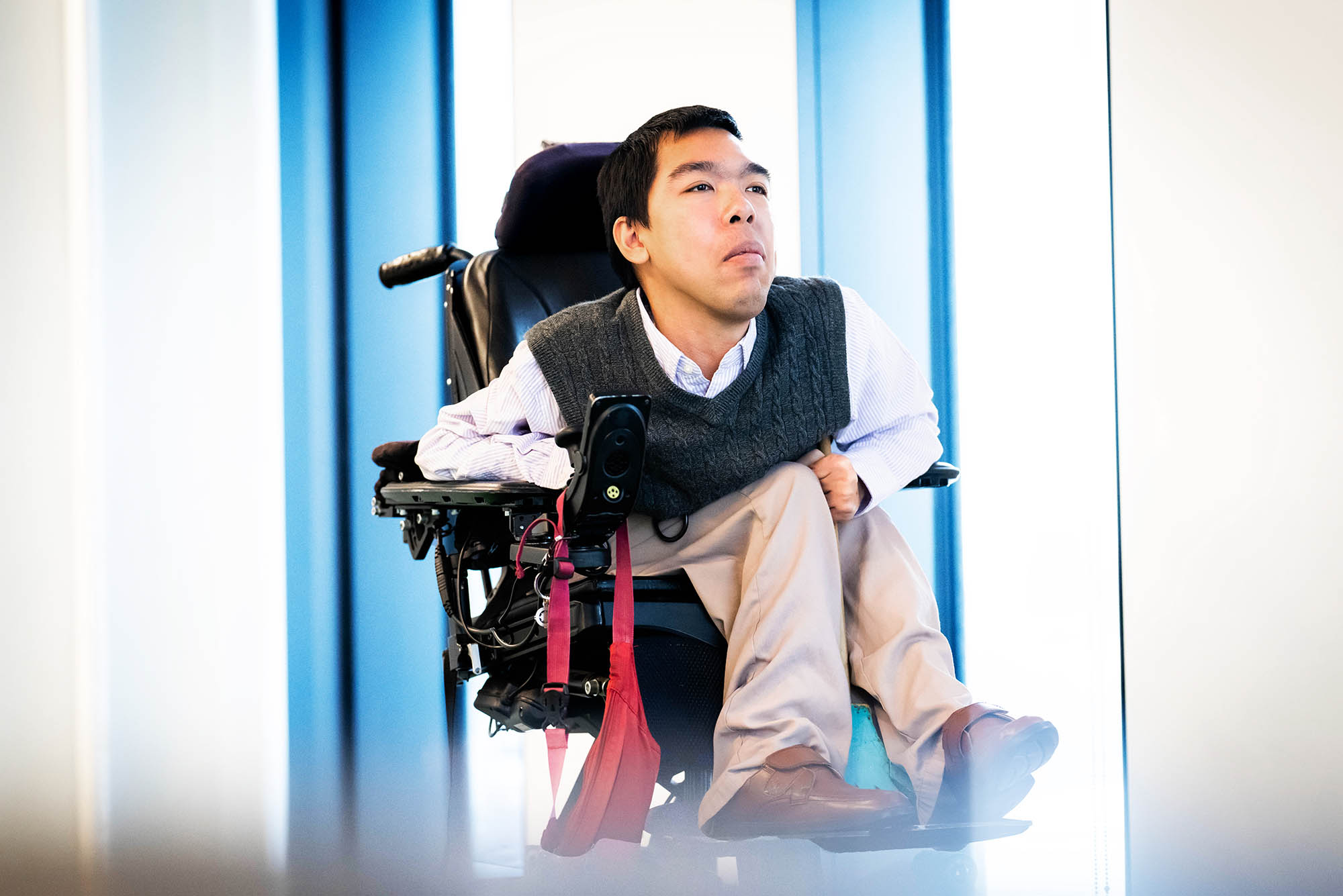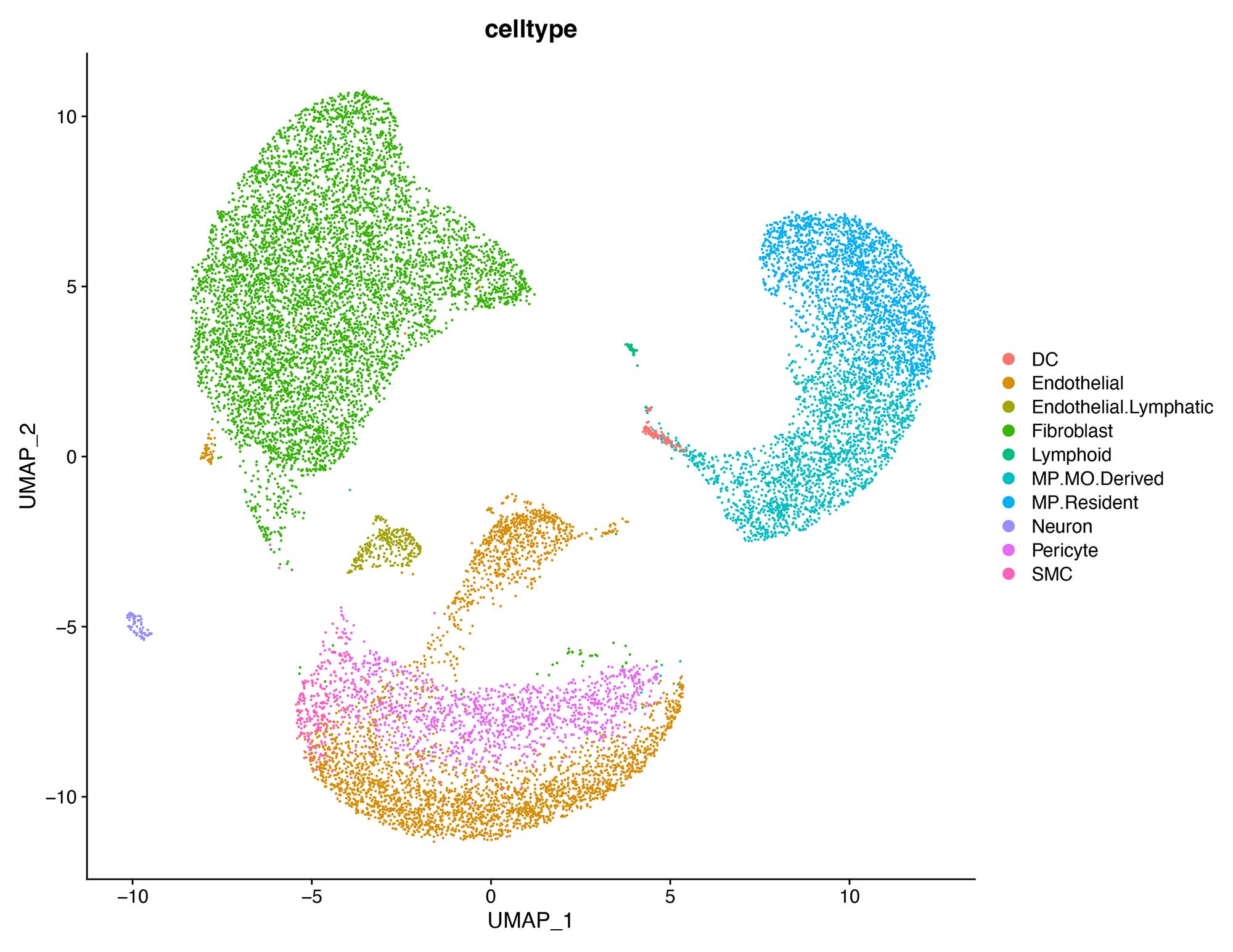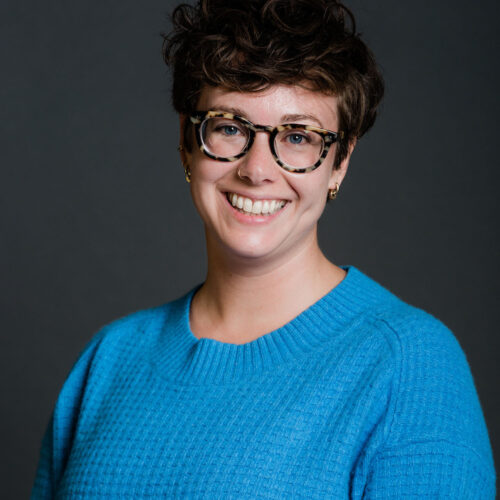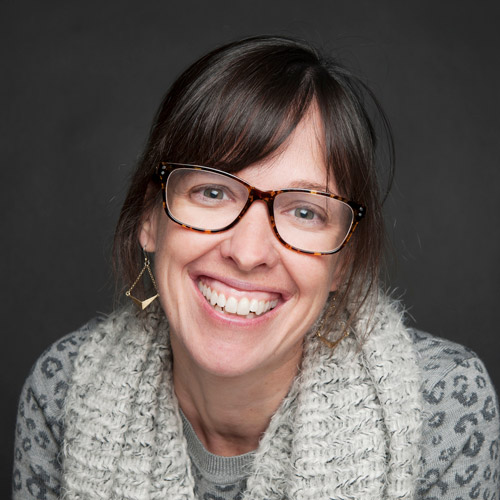Born with Muscular Dystrophy, Justin Moy Now Seeks to Defeat It
“My life’s goal is to cure my disease, and that’s really what drives me every day,” says the BU PhD candidate

Born with Muscular Dystrophy, Justin Moy Now Seeks to Defeat It
“My life’s goal is to cure my disease, and that’s really what drives me every day,” says the BU PhD candidate
As disorders go, muscular dystrophy is not a kind one. A genetic disease that causes muscles to weaken over time, it precipitates a gradual decline that makes it increasingly difficult to move, can cause the spine to curve, and eventually leads to serious complications in the hearts and lungs of its patients. There’s no cure, and scientists are still struggling to understand its exact mechanisms.
How does it travel through muscle cells? What are the specific gene mutations that cause its various forms? Why does it affect some patients from birth and others later in life?
Justin Moy, a third-year bioinformatics PhD candidate at Boston University, is one of the scientists trying to crack the disease’s genetic code. He hopes that by analyzing existing cellular data, he can help create a pathway for better treatments—and, potentially, a cure. But, for him, this isn’t some abstract scientific exercise. Moy (CDS’25,’27) was born with the specific type of muscular dystrophy—known as LAMA2-related muscular dystrophy—that he’s now studying.
“My life’s goal is to cure my disease, and that’s really what drives me every day,” Moy says.
In his quest for a cure, Moy is taking an unexpected route: he’s joined the lab of Pawel Przytycki, a BU Faculty of Computing & Data Sciences assistant professor of computing and data sciences.
“I didn’t know anything about LAMA2 muscular dystrophy—or really muscular dystrophy at all—before Justin came and joined the lab,” says Przytycki. “I was a data person.”

Specifically, he was a data person who’d been studying large-scale genomics data, including how cardiomyocytes (the cells that make up the heart muscle) communicate with one another. Przytycki had developed computational methods to create a clearer picture of which cells carry which information, and how that information travels. Understanding this cellular game of telephone could eventually help us understand how to act when the information gets garbled. Bad information at the cellular level can lead to all sorts of disorders throughout the body, including heart disease—and, Moy argued, muscular dystrophy.
Moy saw a link between Przytycki’s research into cell communication and what scientists know about how muscular dystrophy progresses through the body, one cell at a time. The methods already in use in the lab—including incredibly complex analytical techniques such as bulk RNA sequencing, single-cell transcriptomics, and spatially resolved transcriptomics—are all ways of understanding how cells carry out the instructions coded by our DNA to build and multiply. For researchers such as Moy, they can also be used to understand where those instructions go awry.
“I’ve Always Wanted to Be Able to Contribute”
Moy was born with LAMA2-related muscular dystrophy, a version of the disorder that is the result of a mutation in a gene in charge of instructions for making proteins known as laminins. Scientists have identified more than 30 types of muscular dystrophy, all of them relatively rare among the general population; in the US, all of the different types combined affect about 16 to 25 per 100,000 people. Still, like all muscular dystrophies, LAMA2 causes weakness and atrophy of skeletal muscles as time goes on.
Moy was diagnosed when he was just months old, a determination that was later confirmed with genetic testing when he was 15 years old. Those early months were “a frightening time for my family,” Moy says, as they scrambled to understand what the diagnosis meant for Moy and his future—as well as for themselves.
“As new parents, what did that mean? How would we manage?” says Moy’s mother, Prow, in an interview with the patient advocacy group LAMA2 Europe. But even in those early weeks and months, Prow remembered the gentle advice from Moy’s pediatrician: no child is the same as any other. “With that wisdom, I knew I had to be flexible, be adaptive, and just go with the flow as any new parent would,” she says.
Moy recalls a fairly normal upbringing, with some noticeable differences. For example, he attended preschool with all of his peers without visible disabilities, he says, while also balancing occupational and physical therapy programs.
It was also during preschool that he got his first mobility device—a manual wheelchair that replaced the stroller his family had been using.
As Moy grew through the school system, his peers in Concord, Mass., expressed curiosity about his disability, “but were never malicious,” he says. In elementary school, his fourth-grade teacher helped Moy train his upper body for the mandatory mile-run test; Moy recalls pushing his wheelchair around the track while his classmates cheered him on, “despite finishing a full 20 minutes after them,” he says with a chuckle.
Moy sang in the school choirs and performed in school plays. In middle school, he got his first motorized wheelchair, which enabled him to continue participating in school activities.
Despite these varied interests, by the time Moy was headed to college, he had a firm grasp on his goals.
I know that if I want to see change within my lifetime, then I need to be a changemaker here.
“For as long as I can remember, I’ve always wanted to go into science,” he says. “I’ve always wanted to be able to contribute.” At first, he envisioned himself in a wet lab, studying biology by manipulating physical, biological material.
“But the realities of living with a physical disability mean that that’s not really feasible,” he says. “And so I decided to go into bioinformatics, because I knew that I could contribute intellectually—at least through the use of computers, through the use of programming—and still be able to contribute to that biology.”
Bioinformatics utilizes computers and other tools to analyze biological data, such as DNA and RNA sequences, at a large scale. Moy earned his bachelor’s degree in bioinformatics and computational biology at Worcester Polytechnic Institute (where he also learned how to play the guitar), and joined BU’s PhD program in 2022.
Being a patient gives Moy a unique perspective in his research. Where a disinterested scientist might home in on more theoretical work, Moy says he approaches his work with an eye toward developing “measurable improvements to quality of life.”
“I know that if I want to see change within my lifetime, then I need to be a changemaker here,” he says.
Pushing the Boundary of Human Knowledge
Przytycki’s lab focuses mainly on methods development. Unlike a wet lab, where scientists study samples they’ve collected, the researchers in Przytycki’s lab aim to create new analytical techniques (in the form of computer software) to gain fresh insights from samples other people have collected. Highly interdisciplinary, their bioinformatics work pulls from aspects of biology, chemistry, physics, computer science and programming, data science, information engineering, mathematics, and statistics, to tackle complex questions, such as how diseases develop and progress in the body.
“We work with a lot of different collaborators, and not only do we analyze their data, but we also develop new ways to analyze that data so we can get better biological significance,” Moy says.

For the LAMA2 research, Moy and Przytycki are collaborating with a researcher in Brazil, scientists from the National Institutes of Health, and their colleague Ruben Dries, a BU Chobanian & Avedisian School of Medicine assistant professor of medicine, to analyze the gene expression within bicep muscle samples from people who have muscular dystrophy.
Dries will use a high-powered microscope to scan these muscle samples (“Think of them like core samples of ice,” Moy says) for specific genes, as identified by Moy and his colleagues through the careful examination of existing data on Duchenne muscular dystrophy.
“We’re looking for genes that look different between healthy and diseased tissue,” Przytycki says.
They’ll get a spatially localized readout of the specific genes being expressed in each of the samples—data they hope will give them insight on a host of questions.
Are certain genes switched off in the stiff, fibrotic tissue affected by muscular dystrophy compared to the neighboring healthy tissue? Or vice versa? Are these diseased cells using specific communication channels to pass along faulty genomic instructions to their healthy counterparts? And, if so, might it be possible to interrupt those points of communication to block the gradual breakdown of muscle tissue associated with muscular dystrophy?
It’s that last question that Moy and Przytycki have in their sight line, for now.
“We really want to focus on cell communication, because that’s more targetable for a drug,” Przytycki says. If they can identify the messenger molecules whose signal results in disease in another cell, it would be like handing a road map to a pharmaceutical company: divert traffic here and avoid a jam.
“That would be the dream,” Przytycki says.
This is slow, painstaking work, the vast majority of it focused on the development of computational methods to identify the genes that researchers like Dries should be testing for in the first place. And, for now, Moy and Przytycki are applying for funding that would enable them to run the tests on those muscle biopsy “core” samples.
But Moy, who is singularly focused on this research, is patient.
“The way that I see my work is that every day, you come in and you push the boundary of human knowledge—whether or not it turns out to be useful,” he says. “It can be frustrating during the day-to-day sometimes, but I think that there is always that motivation to move knowledge forward, and there’s the motivation in knowing that even if you’re not helping somebody today, you’re helping them in the future. I think that’s what keeps me going.”


Comments & Discussion
Boston University moderates comments to facilitate an informed, substantive, civil conversation. Abusive, profane, self-promotional, misleading, incoherent or off-topic comments will be rejected. Moderators are staffed during regular business hours (EST) and can only accept comments written in English. Statistics or facts must include a citation or a link to the citation.